Some product photos courtesy of Columbia and Rule
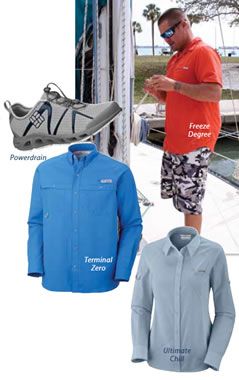
With Mothers Day upon us and Fathers Day just around the corner, we put together a few gift ideas for sailing families. Our grab bag includes gear for warm-weather and small-boat sailors, the galley slave, and the boat-maintenance aficionado.
Cool Sailing Clothes
Columbia Sportswear has come out with an innovative, new fabric technology: Omni-Freeze Zero (OFZ). This new technology, which has been incorporated into Columbias spring 2013 line of clothes and shoes, is designed to cool the wearer in hot, moist conditions.
Rather than simply wicking away sweat like most activewear fabrics, the Omni-Freeze Zero material actually has a cooling sensation. Testers likened it to taking a drink out of the fridge and holding it against your skin.
How it works: Distinctive little blue rings that are embedded into the material contain a special concentrated cooling polymer. The wicking polyester base of a single Omni-Freeze Zero shirt has tens of thousands of these 0.15-inch hydrophilic polymer rings. When exposed to sweat or other moisture (spray, rain, spilled beverage), the rings absorb it as it wicks across the fabric, and they expand into three-dimensional doughnuts, creating an instant and prolonged cooling sensation. (In order to swell, the rings require energy, which they gather from surrounding heat sources.)
Testers checked out a few of the new OFZ styles-the womens Ultimate Chill Zero and mens Terminal Zero and Freeze Degree shirts-and found the polyester shirts comfortable, lightweight, easy to move in, and pleasant against the skin. Not all of the designs have vents, but the fabric kept testers feeling cool in hot and humid weather. When sprayed with water, the hydrophilic polymer rings cooling properties were especially noticeable. The shirts were easy to wash and dried quickly.
They all have UPF 50 sun protection, and some have a flip-up collar for further sun protection; the long-sleeve, button-down shirts have roll-up sleeves with tabs. Most of the shirts we tested have buttons, but some feature snaps at the front closure; testers prefer buttons over metal snaps on saltwater sailing apparel.
The cooling technology and extra design details do not come cheap; the shirts we tested range from $90 to $100. We recommend them for warm-weather sailors looking to invest in quality technical clothing with sun protection. Theyre pricey, but we like the cooling sensation and limited lifetime warranty. There are other products in the OFZ line that are less expensive, including a womens tank top ($45) and sun hats ($25), which well look at in an upcoming test.
Cool Kicks
The Powerdrain Cool Shoes (mens and womens) use the same Omni-Freeze Zero technology as the shirts. The attractive shoes, with mesh uppers and a sturdy sole, are comfortable and practical for all-day wear on board.
PS testers wore the Powerdrain shoes during daily activities, daysails, and daylong races, and we found them to be plenty light weight, comfortable, and breathable. The upper is a single-layer mesh that allows for air and water to flow through the shoe, and in tests, they drained quickly and held no water in the footbed; however, they did not dry as quickly as others weve tested. The cushioned midsole offers good support for extended wear and is removable for faster drying. The shoes have cord laces with a toggle slide and a fabric pull-on loop at the heel.
The siped, nonmarking rubber soles provide great traction. PS tested the Power-drain shoes on our inclined shoe-testing device, and found them to be grippy and give sure footing on teak and fiberglass. The shoes performance matched that of our past top picks.
When shoes develop a stink that can’t be washed or bleached away, its usually the result of sweaty feet bacteria. The Powerdrain shoes are lined with the Omni-Freeze Zero fabric, which creates a cooling feeling when your feet sweat-a nice feature for summer sailing. Testers found no discernible odor or excessive wear after testing the shoes in hot and wet conditions. We plan to long-term test them for odor resistance and durability, and will report any findings.
The shoes retail for about $90 and carry a one-year limited warranty.
Comfort, innovative materials, and excellent traction make the shoes a great fit for those who sail in warm climates. However, if youre ordering for someone who wears a half size, we suggest ordering a size down as these do run large.
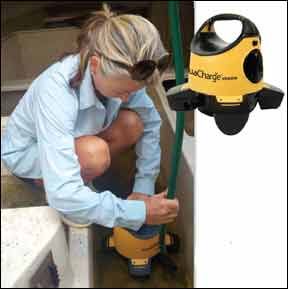
Portable Pumps
Testers took a look at the new Rule AquaCharge Xtreme portable, battery-powered water pump, and its smaller predecessor, the AquaCharge rechargeable bilge pump.
Each pump is powered by a rechargeable NiMH battery, and comes with a 12-volt DC vehicle-style charger, an AC wall charger, and a charging cradle. They can pump both fresh and salt water.
The 3.6-pound, fully submersible (up to 6 feet) AquaCharge Xtreme is rated to pump 10 gallons per minute, with a vertical lift up to 17 feet, and can pump 600 gallons on a single charge. Using 17 feet of garden hose and a swimming pool, PSs bench tests confirmed these claims. The Xtreme pumped steadily for 45 minutes before running out of battery juice. The depleted battery took two hours to fully recharge; the instructions say four hours are required.
We used the cordless Xtreme to pump out the bilge of PSs Catalina 22, which had collected rain water and leaves over the winter. The pumps excellent filter kept the leaves and gunk from clogging the intake, but over an inch of water remained in the bilge when the pump began sucking air. The design is such that the hose-less intake is about an inch above the surface where the pump is set.
The pump, which measures 9.5 inches high by 10.5 inches wide, has four feet at its base. These create a wide platform that is great for stability but limits its use in tight quarters on board.
The Xtreme costs $160 (MSRP) and includes pump, charger power adaptor, battery charger base, battery cartridge, and 90-degree nozzle. A discharge hose is not included.
The smaller AquaCharge pumps approximately 8 gallons per minute, 200 gallons on a single charge. Fully submersible (to 6 feet), the lightweight, portable pump is 7 inches tall, 5.5 inches long, and 3 inches wide. Testers liked the simple, ergonomic power control knob and its threaded discharge.
We found the AquaCharge online for about $60 with a one-year warranty. The kit comes with the pump, charger power adaptor, battery charger base, battery cartridge, and 8 feet of hose.
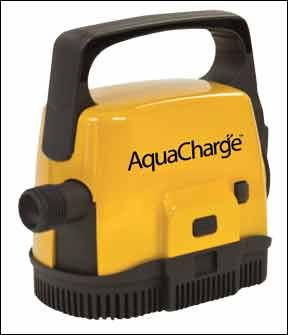
Both pumps are easily portable and work as advertised. Testers particularly liked their easily removable filters, which allowed for quick and efficient cleaning. The smaller AquaCharge may be more versatile onboard, especially on smaller boats, as the powerful Xtreme wont fit in tight bilges and leaves some water standing. Either pump would be useful for clearing water from small, open boats (dinghies, daysailers, etc.) or cleaning out compartments that don’t drain to the bilge. The Xtreme could also double as backup emergency bilge pump-so long as the battery is kept fully charged-and could be put to work ashore as well.
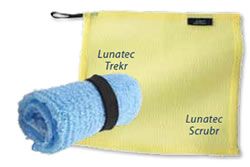
Cleaning Up
Lunatecs nylon/polyester travel cloths-one for bathing and one for dishwashing-came highly recommended to us by The Boat Galley Cookbook co-author Carolyn Shearlock, and they did not disappoint.
The Trekr is a super lightweight bath cloth (10 grams) made from quick-dry nylon. Testers found it perfect for scrubbing the body, and it was even suitable for facewashing. It exfoliated the skin, leaving it feeling clean and polished.
The Trekr rinses clear of soap and debris during use. Because it doesn’t hold water, it doesn’t mold or smell. Our test cloth dried in less than 15 minutes and never developed any odor, even after weeks of daily use.
An elastic loop on the cloth can be used to hang-dry the Trekr and as a compression strap for storage. The cloth takes up very little space and comes in two sizes: 10.5 by 10.5 inches and 35 inches by 11 inches. A two-pack of Trekr cloths costs $8.
We sentenced Lunatecs Scrubr dish cloth to a few weeks of galley use-testing it against tomato paste, fried eggs, sticky rice, and oatmeal-and the cloth prevailed. Made from 60-percent nylon and 40-percent polyester, the Scrubr is more abrasive than the Trekr and was excellent in tackling a variety of dirty and stained dishes. It easily rinsed free of food and debris, and did a good job of holding soap. Our test Scrubr had no odor after weeks of use. According to the maker, the poly-nylon material has less bacteria buildup than sponges and cotton dish cloths, and wed expect it to outlast a typical dish sponge.
The Scrubr has the same hanging loop/compression strap as the Trekr, and it comes in 8 inches by 8 inches. It weighs only 5 grams, and costs $5.50 per two-pack.
Both the Scrubr and Trekr are ideal for use onboard (and camping)-or for anyone on the go, really. For those who have to travel far to get to their boat-like flying to a charter-wed definitely pack a few of these.
Maintenance Fanatics
For the consummate do-it-yourselfer, we checked out natural-bristle brushes from Robert Larson Co. The company offers a full range of imported paint brushes and woodworking tools, but we limited our review to finishing brushes for oil-based coatings, since a quality brush really only makes sense for a boat owner to use with topside paints and varnishes.
Made in France, the brushes have hardwood handles, galvanized steel ferrules, and 100-percent hog hair bristles. Most natural bristles are made from hog bristle (often called China bristle because China is the largest supplier of them), and a good-quality China bristle is adequate for most finishing jobs. Synthetic bristles are less expensive, but they lack flagged (split) bristle ends, so they don’t hold as much paint or lay it on as evenly.
The Larson finishing brush has an oval ferrule with hand-trimmed bristles that have a curved shape and flagged ends. While thick bristles with split ends mean the brush will have more paint capacity than a flat-edged brush, the handcrafted, curved shape and oval cross-section allow for better flow out and more even strokes; oval brushes are the best bet for top-coating varnish or tipping-out LPU.
Larson sells several sizes of finishing brushes (1, 2, and 3 inch), and we tested the 2-inch brush. At 2 ounces, the brush has just enough heft, and its ergonomic handle is easy to hold and use. The stable of bristles is a half-inch thick and has no filler. The maker uses epoxy to adhere the bristles, and our test brush shed only a few strays when we first opened it. None were shed when we used the brush. (We always recommend cleaning stray hairs from the ferrule with painters masking tape before each use.)
Choosing the right brush for marine-coatings application will depend on the job, the budget, and the users preferences. A well-cared-for, quality brush can offer satisfying results for many years. We last reported on natural-bristle brushes in the April 2011 issue and tapped Epifanes Omega Lily as our top pick for applying high-solids varnishes and topside paint. The 2-inch Chinese ox-hair Epifanes ($45) is a premium brush fit for the varnish fanatic. The Larson finishing brush ($15-$32, depending on size, at www.amazon.com or www.rlarson.com) is comparable, but its better suited for the varnish enthusiast on a budget.
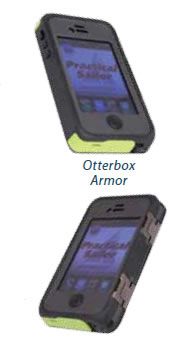
Bulletproof Box
At long last, Otterbox has released a case for smartphones that is totally waterproof-and doesn’t include the annoyingly sticky rubber that its Defender cases have. The Armor series cases, available for the Samsung GS3 and iPhone 4/4S/5, are rated as submersible to 6.6 feet for 30 minutes and shockproof to drops of 10 feet onto concrete. We decided to test one out to see whether it would be a good gift idea for the mobile sailor, iPhone navigator, or liveaboards whose phones live on the water too.
The most robust smartphone case weve ever seen, the Otterbox Armor is heavier and bulkier than the LifeProof, our top pick in the November 2012 test. We tested the iPhone 4 version, which measures 5.14 inches by 2.94 inches by 0.82 inches. Empty, it weighs 4.23 ounces-more than an ounce heavier than the streamlined LifeProof. Made of industrial-strength, reinforced, non-sticky plastic, the Armor features an interior bed of silicone that cradles the phone and scratch-resistant covers for the screen and camera lens. Attached silicone plugs with O-rings protect the headphone and charging ports, and heavy-duty, non-corrosive metal clips hold the plastic case together so securely that it would be impossible to accidentally open it. Testers found that the silicone plugs were well seated and kept the ports totally dry during submersion. We tested the cases water resistance in a freshwater pool (6 feet for 30 minutes), and there was no sign of leaks.
The plugs made it easier to access the headphone and charging ports than the LifeProofs thumb-screw and flip-down panel port covers, but you wouldnt be able to use headphones with it underwater, as you can with the LifeProof. (We recommend double-checking that these are properly sealed any time the ports are not in use.) Testers also found it easier to put the phone in the Armor or take it out than it is with the LifeProof.
PSs male testers had no problems holding the Otterbox Armor, using it with one hand, or fitting it into pants pockets; however, our petite women testers noted that the case was less ergonomic than the LifeProof and impossible to fit into pockets.
Well suited to 24/7 use, on or off the water, the Armor allows full function of the phone while its in the case, but the rubber button actuator for ringer on/off will take some getting used to, testers said. Testers also reported that hearing voice calls was difficult when there was a lot of background noise, but the case does not muffle outgoing voices or music at all.
The Armor is a tough case with excellent waterproof and shockproof protection, innovative engineering, and long-lasting durability. It would be a great gift for the sailing dad who wants a more bulletproof phone case than the LifeProof. At $100, the Armor costs a little more, but you can expect it to outlast most other cases. If youre shopping for a petite mom, stick with the $80 LifeProof.




































